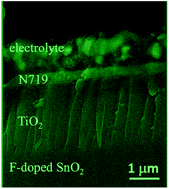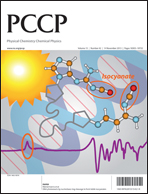Effects of calcination treatment on the morphology, crystallinity, and photoelectric properties of all-solid-state dye-sensitized solar cells assembled by TiO2 nanorod arrays†
Abstract
TiO2 has been extensively investigated due to its unique photoelectric properties. In this study, oriented single-crystal rutile TiO2 nanorod arrays were synthesized and then calcined at different temperatures in the atmosphere. The morphology and crystalline characterization indicated that the length of TiO2 nanorods increased rapidly and the nanorods became aggregated and fragile after calcination, yet the sintering treatment seemed to have almost no effect on the crystallinity. To obtain the all-solid-state, dye-sensitized solar cells (DSSCs), a newly reported solid inorganic semiconductor, CsSnI2.95F0.05, was employed as the electrolyte, and the Pt deposited on the conductive side of the fluorine-doped tin oxide (FTO) glass substrate was used as the counter-electrode. The effects of the calcination treatment on the photoelectric properties of the solar cells, including external quantum efficiency (EQE), open circuit voltage (VOC), short-circuit current (JSC), and photoelectric conversion efficiency (η), were investigated under the illumination of a solar simulator. As a result, all of the EQE, VOC, JSC, and η values of the cells first increased and then declined with the increase of calcination temperatures, and the highest η of 2.81% was obtained by the cell assembled with its TiO2 electrode sintered at 450 °C for 3 h, a value almost 2.5 times that of the non-sintered sample (1.1%).


 Please wait while we load your content...
Please wait while we load your content...